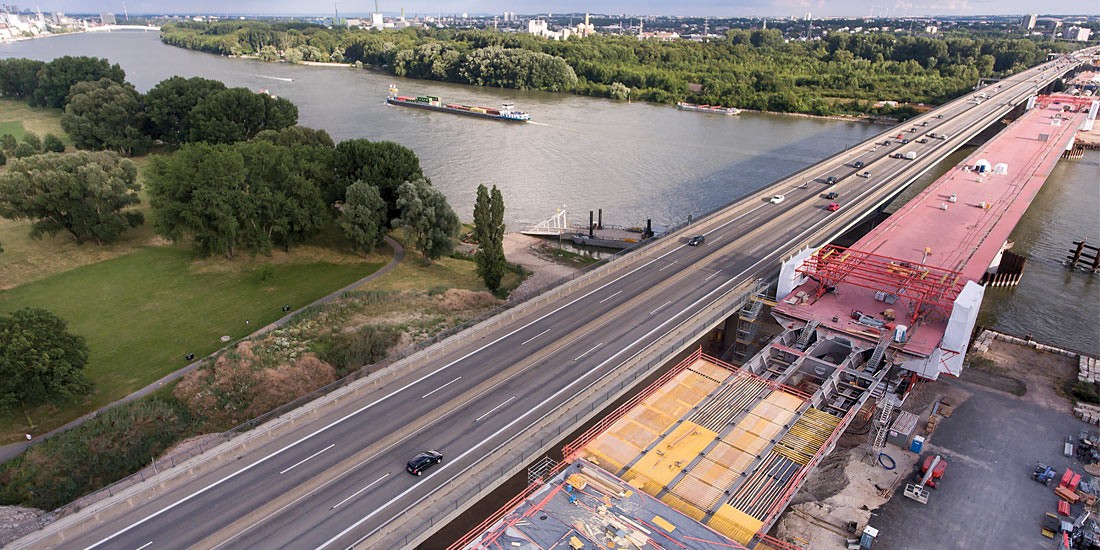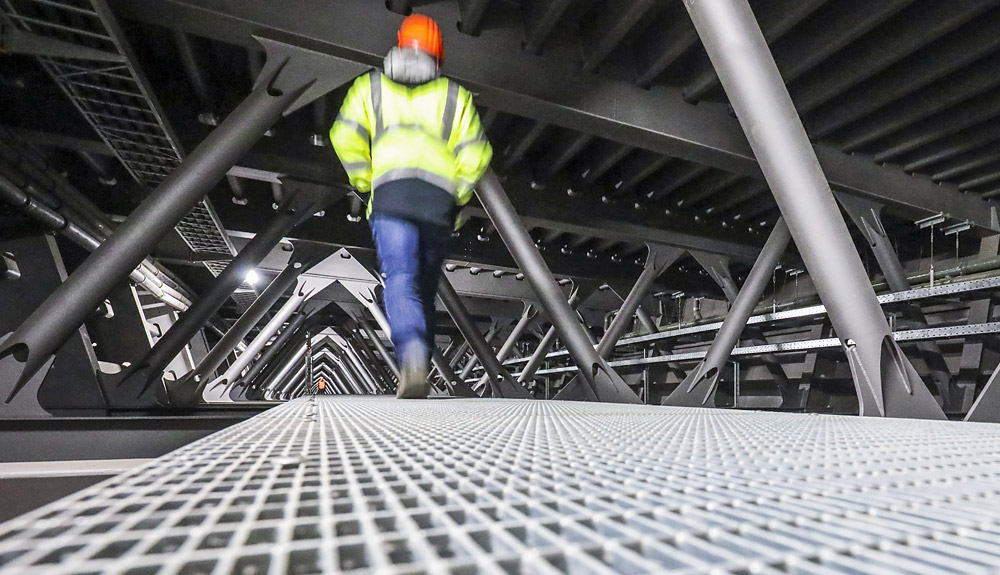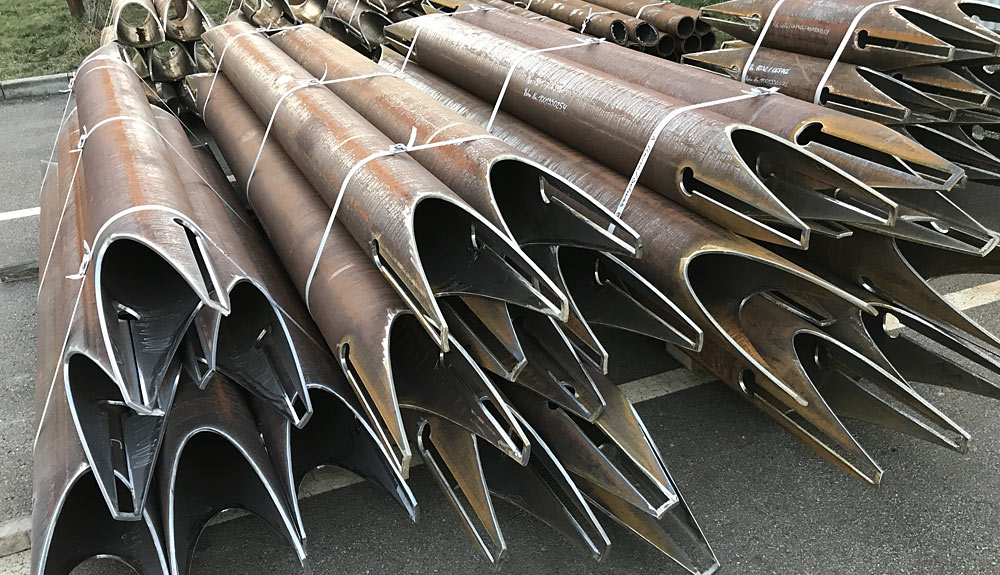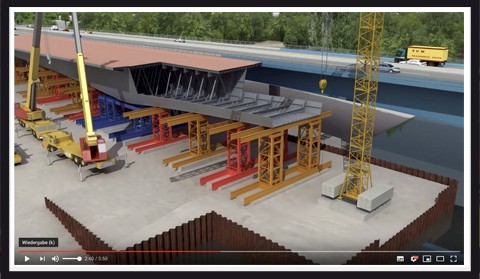Reconstruction of Schiersteiner Bridge
A bridge for 100 years of mobility
Nowhere else can mobility, transport and logistics be experienced as clearly as in road traffic. After its reconstruction, the Schierstein motorway bridge in Rhineland-Palatinate is more stable, lighter and more cost-effective, thanks to the optimized design of its steel structure. The HFI-welded steel tubes used for this purpose were supplied by Mannesmann Line Pipe.
On 10 February 2015, at around 10 pm, considerable damage was detected in the Schiersteiner Bridge on motorway A 643. One pier of the more than 50-year-old foreland bridge had tilted, whereupon the carriageway was lowered by about 30 cm. The bridge was then closed immediately. On the day after, the importance of the bridge, as a part of the "Mainzer Ring" between Hesse and Rhineland-Palatinate, made itself felt in rush-hour and interregional long-distance traffic: Tailbacks of several kilometers, diversion chaos through Mainz, Wiesbaden and the surrounding area not only strained the nerves of tens of thousands of commuters and truck drivers, but also those of the planners and road workers who had been working for two years now on one of Germany‘s largest transport infrastructure projects.
New construction project brings old bridge to its knees
It was work on the piers for the new Schiersteiner Bridge that caused this incident. After a two-month full closure, the old bridge was initially re-opened with some restrictions, and then, in autumn 2015, to heavy traffic as well. All those affected and involved breathed a sigh of relief!
A long way to the groundbreaking ceremony
Planning for the "old" Wiesbaden-Schierstein Rhine Bridge started in 1955. At that time, a traffic volume of 7,100 vehicles per day was forecast, and the bridge was designed for a maximum 20,000. Today, up to 86,000 vehicles cross the Rhine at this point every day. No wonder, then, that the bridge has long been in need of rehabilitation.
A design contest for the construction of a new bridge was held in 2007. The winning entry by a consortium consisting of the engineering firm Grontmij BGS and the architectural firm Ferdinand Heide designed a 1,285 m long box girder bridge. The construction project envisages the successive realization of the new bridge with two separate superstructures. The bridge sections are each 21.72 meters wide and designed for three carriageways and a hard shoulder as well as a cycle path and sidewalk. The ground-breaking ceremony for the new bridge was held on September 11, 2013.
The design is the most economical solution in terms of both maintenance and production costs.From the jury‘s reasoning on the winning design
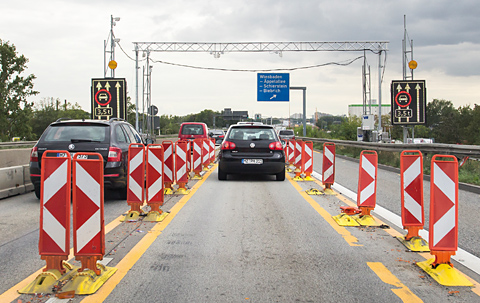
The limited use of the "old" Schiersteiner Bridge caused miles of traffic jams and great irritation among all those involved. Image: © iStockphoto.com
Bridge construction in three phases
Originally, the plans were based on the assumption that the new bridge structure would be completed by 2019, but the lowering and closure of the existing bridge in February 2015 had completely disrupted the timetable. First of all, the old bridge had to be repaired and upgraded for current traffic requirements.
The new bridge is essentially divided into three construction phases. Phase one began in 2013 with the construction of the so-called downstream bridge in the direction of Mainz until late summer 2017. This included the foundation work on the Wiesbaden side, the fabrication and assembly of the steel superstructures and the construction of the concrete superstructures. After completion of the remaining work, such as road surfacing and marking, erection of the gantry signs, installation of the drainage system and the supply lines, the first construction stage could be put into operation. Since November 20, 2017, traffic has been flowing in two lanes in both directions over the new bridge half. That accomplished, the second construction phase began with the demolition of the existing bridge. For reasons of nature conservation and safety, the bridge was demolished and not blown up. Meantime, the project is in the middle of its third phase, with construction work on the bridge in the direction of Wiesbaden.
Deliveries for both bridge halves
After successful deliveries for the first construction phase until 2017, Mannesmann Line Pipe once again delivered around 220 tons of HFI-welded tubes in grade S 355 J2H steel for the second half of the bridge. In accordance with DIN EN 10210 and DB specifications, defined restrictions had to be met for the chemical analysis regarding the carbon, phosphorus, sulfur and boron contents. Furthermore, the test specifications had to be tightened in terms of the test temperature, which was lowered to -20 °C. The tubes in size 244.5 x 10 and/or 12.5 mm were manufactured in Siegen and initially delivered to ZIS Industrietechnik in Saxony via the dealer ProPipe from Willich, North Rhine-Westphalia. There the tubes were flame-cut to specification, slit at the ends and beveled as a preparation for welding to structural components at the steel fabricators Max Bögl and Plauen Stahl. They were able to call off the tubes in line with their process flow. The finished components were then sent to the construction site where they were welded to the box girders as planned.
Optimized design for greater stability
The optimized design of the steel structure provided for significantly higher stability. In addition to immense savings in material and costs, this will ensure a long service life for the new bridge. In fact, at 100 years, its design life is twice that of its predecessor.
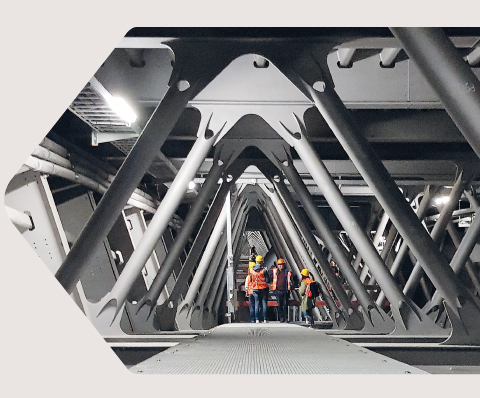
Foto: © Hessen Mobil
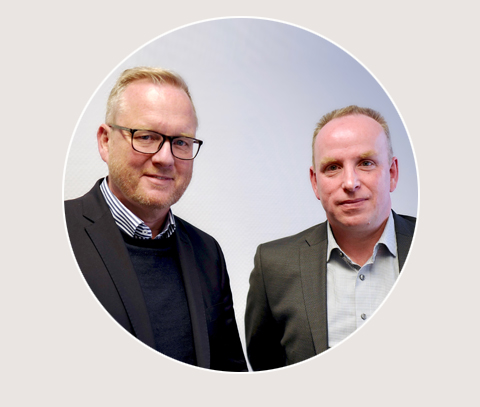
Bernd Hollaender, Managing Director ProPipe and Guido Ludwig, Regional Sales Manager, Mannesmann Line Pipe
A very special on-site meeting
Anyone who always thought that one could only stand on or under a bridge would probably have been set right in September 2018: The bridge experts from "Hessen Mobil" had sent out invitations to a very special on-site meeting inside the new bridge. The entrance point was in Rheingaustraße on the Wiesbaden side. Together with the organizers of Hessen Mobil, the attendants crossed the Rhine inside the bridge over a distance of 1,280 m. They were enthusiastic. Who would have expected that the interior of the new bridge would look so futuristic? Each of the six girder boxes is up to eight meters high and 20 meters wide. The path leads over a narrow walkway, and over a length of around 200 meters there is virtually nothing to be seen but rows of steel tubes, as well as steel girders and steel walls. Then it gets tight: bent over and one at a time, the attendants had to pass through a narrow opening to get from one box girder into the next.
Completion of a mammoth project
Up to 100 people per day worked on the bridge construction site as the earthworks for the new piers for the second half of the bridge, the demolition of the old structure and steel works were all carried out at the same time. Final completion is planned for autumn 2020, and in 2021 the complete bridge will be opened for traffic.
Detail with great effect
The optimized design achieved significantly higher stability in the steel structure.
Oval cut-outs at the tube ends allow the inner strut structure to be welded to the box girder on both sides. This ensures force-locking joints and considerably higher stability in the entire bridge structure. According to the bridge experts at Hessen Mobil, the optimization allowed the wall thickness of the steel tubes to be reduced by almost 50 percent. This not only saves material and costs, but also ensures appreciably greater durability for the new bridge: At 100 years, its design life is twice that of its predecessor.
Photo: © ZIS Industrietechnik GmbH
Complex structure, complex logistics
On-site preparations for the construction of the 1,280 m long steel superstructure were quite considerable. On the one hand, Rettbergsaue – the Rhine island crossed by the bridge – is a nature reserve, on the other hand, interference with river transport was to be kept at an absolute minimum.
The new bridge is part of the three-lane extension connecting to the A66 at the Schiersteiner Kreuz (junction). The first section in the direction of Mainz was built parallel to the existing bridge on newly founded supports. The new foundations for the bridge piers in the Rhine rest on up to 33 m deep piles. After completion of the welding work, the respective steel section was pushed 90 m in the direction of the Rhine on a feed track. As not only the Rhine but also a side arm had to be crossed, the procedure was carried out four times per direction of travel, i.e. eight times in all. The two gaps were closed from a floating pontoon on the Rhine.
Positioned on a 2,000 t steel structure, the approx. 120 m long middle sections were floated to the installation site by means of tugboats and barges. With the aid of hydraulic presses, they were lifted into the correct position and then welded to the structure. It was only for these maneuvers that navigation on the Rhine had to be interrupted. In the direction of Wiesbaden, the existing bridge piers were retrofitted and repaired in the Rhine. Apart from that, procedures in the second phase were the same as in the first. The opening of the new bridge is planned for 2021.
